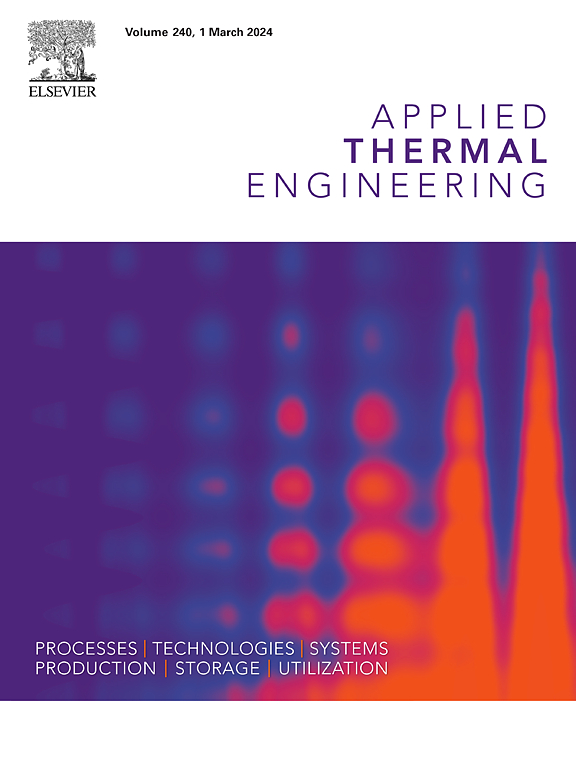光学误差对直接产汽抛物面槽集热器热工性能的影响
IF 6.1
2区 工程技术
Q2 ENERGY & FUELS
引用次数: 0
摘要
抛物槽太阳能直接蒸汽发电(PTC-DSG)技术是将清洁能源与绿色载体巧妙结合,实现低碳未来的有利技术之一。实际运行中存在各种光学误差,导致热流分布畸变,影响 PTC-DSG 的性能,但对不同光学误差下吸收管两相流动和传热性能的研究相对缺乏。本文基于蒙特卡洛射线追踪法、有限体积法和欧拉多相流模型,建立了 PTC-DSG 集热器的光-热-流耦合模型。全面研究了斜率误差(σs)、跟踪误差(σt)和吸收器安装误差(σx 和 σy)下吸收管的传热性能和两相流。结果表明,光学误差引起的圆周温度分布畸变对吸收管的传热性能和可靠性有显著影响。σs 使温度分布更加均匀,但显著降低了吸收管的最大圆周温度 (Ta,max)、圆周温差 (CTD)、收集器效率 (ηc) 和蒸汽体积分数 (VVF),并减少了对 DSG 收集器的威胁。高 σt (>8 mrad) 显著影响吸收管的两相流动和传热性能,使 Ta,max、CTD 和 VVF 迅速降低,蒸发和过热阶段的 ηc 也分别降低了约 33.3% 和 34.2%。σx和σy对吸收管流动传热性能的影响较小,但对其圆周温度分布和CTD的影响较大。σy(>0 mm)造成的圆周温度分布最不均匀,威胁到DSG收集器的安全。此外,低工作压力下的吸收管具有较高的ηc 和 VVF,但 CTD 也相应较高。与蒸发阶段相比,过热阶段的吸收管承受的热负荷更大,但 ηc 也更高,尤其是在低工作压力下。本文章由计算机程序翻译,如有差异,请以英文原文为准。
Effect of optical errors on the thermal–hydraulic performance of direct-steam-generation parabolic trough collector
Parabolic trough solar direct-steam-generation (PTC-DSG) technology is one of the favorable technologies to achieve low-carbon future by cleverly integrating clean energy with green carriers. There are various optical errors under actual operation, which cause heat flow distribution distortion and affect the performance of PTC-DSG, but there is a relative lack of research on the absorber tube’s two-phase flow and heat transfer performance under different optical errors. The coupled optical-thermal-flow model of the PTC-DSG collector is established in this paper based on Monte Carlo ray tracing method, Finite Volume method and Eulerian multiphase flow model. The absorber tube’s heat transfer performance and two-phase flow under slope error (σs), tracking error (σt) and absorber installation error (σx and σy) are comprehensively investigated. The results revealed that the circumferential temperature distribution distortion caused by optical errors has a significant impact on the absorber tube’s heat transfer performance and reliability. σs made the temperature distribution more uniform, but significantly reduced the maximum circumferential temperature (Ta,max), circumferential temperature difference (CTD), collector efficiency (ηc), and vapor volume fraction (VVF) of the absorber tube, and reduced the threat to the DSG collector. High σt (>8 mrad) significantly affects the absorber tube’s two-phase flow and heat transfer performance with rapid reduction of Ta,max, CTD and VVF, and ηc in evaporation and superheating stages are also reduced by about 33.3 % and 34.2 %, respectively. The effects of σx and σy on the absorber tube’s flow heat transfer performance are small, but significantly affect its circumferential temperature distribution and CTD. σy (>0 mm) causes the most inhomogeneous circumferential temperature distribution, which threatens the DSG collector’s safety. Moreover, the absorber tube at low operating pressure has higher ηc and VVF, but correspondingly higher CTD. Compared to the evaporation stage, the absorber tube in the superheating stage is subjected to greater thermal loads but also has higher ηc, especially at low operating pressure.
求助全文
通过发布文献求助,成功后即可免费获取论文全文。
去求助
来源期刊

Applied Thermal Engineering
工程技术-工程:机械
CiteScore
11.30
自引率
15.60%
发文量
1474
审稿时长
57 days
期刊介绍:
Applied Thermal Engineering disseminates novel research related to the design, development and demonstration of components, devices, equipment, technologies and systems involving thermal processes for the production, storage, utilization and conservation of energy, with a focus on engineering application.
The journal publishes high-quality and high-impact Original Research Articles, Review Articles, Short Communications and Letters to the Editor on cutting-edge innovations in research, and recent advances or issues of interest to the thermal engineering community.
 求助内容:
求助内容: 应助结果提醒方式:
应助结果提醒方式:


